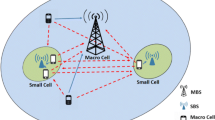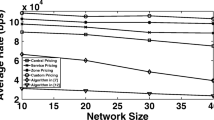Abstract
In this paper, we study the optimal resource allocation problem in a wireless network, where all types of traffic including best effort and quality of service (QoS; Soft QoS and Hard QoS) are described by a unified utility function. The attacked problem is casted into a network utility maximization (NUM) model. We formulate the fairness index in terms of users’ utility and traffic type parameters, and then study their relationships. Law of diminishing marginal utility is widely accepted in economics. In this paper, we establish the principle of equality and diminishing marginal utility that enables us to find the desired optimal solution to the NUM model by using this principle, correspondingly for the case where the total resource is sufficient and for the case where the total resource is insufficient. We propose some essential theorems and algorithms to find the optimal solution for the above two cases. The proposed algorithms are evaluated via simulation results. The theoretical analysis and simulation results not only validate the efficacy and efficiency of the proposed algorithms but also disclose the relation between the optimal resource allocation and the factors of traffic types, total available resource and user’s channel quality and the relation between fairness and total resource with respect to a certain allocation scheme.







Similar content being viewed by others
References
Auer, G., & Giannini, V. (2011). How much energy is needed to run a wireless network. IEEE Wireless Communications, 18, 40–49.
Avestimehr, A. S., Diggavi, S. N., & Tse, D. N. C. (2010). Wireless network information flow: A deterministic approach. IEEE Transactions on Information Theory, 57, 1872–1905.
Balachandran, K., Kadaba, S. R., & Nanda, S. (1999). Channel quality estimation and rate adaptation for cellular mobile radio. IEEE Journal on Selected Areas in Communications, 17(7), 1244–1256.
Cao, Y., & Li, V. O. K. (2002). Utility-oriented adaptive QoS and bandwidth allocation in wireless networks. Proceedings of IEEE ICC, 5, 3071–3075.
Cao, Y., Li, V. O. K., & Cao, Z. (2003). Scheduling delay-sensitive and best effort traffic in wireless networks. Proceedings of IEEE ICC, 3, 2208–2212.
Case, K. E., & Fair, R. C. (1999). Principles of Economics (5th ed.). London: Prentice-Hall. ISBN 0-13-961905-4.
Chen, L., Low, S. H., & Doyle, J. C. (2005). Joint congestion control and media access control design for wireless ad hoc networks. Proceeding of IEEE Infocom, 3, 2212–2222.
Chen, L., Wang, B., Chen, X., Zhang, X., & Yang, D. (Apr 2011). Utility-based resource allocation for mixed trafffic in wireless networks. In Proceeding of IEEE INFOCOM 2011 International Workshop, pp. 91–96.
Dinitz, M. (2010). Distributed algorithms for approximating wireless network capacity. IEEE INFOCOM, 57, 1–9.
Gao, X., Nandagopal, T., & Bharghavan, V. (2001). Achieving application level fairness through utility-based wireless fair scheduling. Proceedings of IEEE Globecom, 6, 3257–32616.
Ghavami, S., & Abolhassani, B. (2012). Spectrum sensing and power/rate control in CDMA cognitive radio networks. International Journal of Communication Systems, 25(2), 121–145.
Jain, R., Chiu, D., & Hawe, W. (1984). A quantitative measure of fairness and discrimination for resource allocation in shared systems. Technical Report, Digital Equipment Corporation, DEC-TR-301.
Jiang, Z., & Shankaranarayana, N. K. (2001). Channel quality dependent scheduling for flexible wireless resource management. Proceedings of IEEE Globecom, 6, 3633–3638.
Jiang, Z., & Shankaranarayana, N. K. (2003). A utility-based power control scheme in wireless cellular systems. IEEE/ACM Transactions on Networking, 11(2), 210–221.
Kabaoglu, Nihat. (2013). Expectation-maximization-based joint data detection and channel estimation for a cellular multi-carrier code division multiple access network using single-hop relaying. International Journal of Communication Systems, 26(4), 449–464.
Kelly, F. P. (1997). Charging and rate control for elastic traffic. European Transactions on Telecommunications, 8, 33–37.
Khanjari, S. A., Arafeh, B., Day, K., & Alzeidi, N. (2013). Bandwidth borrowing-based QoS approach for adaptive call admission control in multiclass traffic wireless cellular networks. International Journal of Communication Systems, 26(7), 811–831.
Kulakowski, P., Calle, E., & Marzo, J. L. (2013). Performance study of wireless sensor and actuator networks in forest fire scenarios. International Journal of Communication Systems, 26(4), 515–552.
Kuo, W. H., & Liao, W. J. (2005). Utility-based optimal resource allocation in wireless networks. Proceedings of IEEE Globecom, 5, 3512.
Kuo, W. H., & Liao, W. (2008). Utility-based radio resource allocation for QoS traffic in wireless networks. Proceedings of IEEE Globecom, 7, 2714–2722.
Kuo, W. H., & Liao, W. (2008). Utility-based radio resource allocation for QoS traffic in wireless networks. IEEE Transactions on Wireless Communications, 7(7), 2714–2722.
Pang, J., Greenstein, B., Kaminsky, M., McCoy, D., & Seshan, S. (2010). Wifi-reports: Improving wireless network selection with collaboration. IEEE Transactions on Mobile Computing, 9, 1713–1731.
Siris, V. A., Briscoe, B., & Songhurst, D. (2002). Economic models for resource control in wireless networks. Proceedings of IEEE PIMRC, 3, 1112–1116.
Siris, V. A., & Courcoubetis, C. (2004). Resource control for loss-sensitive traffic in CDMA networks. Proceedings of IEEE INFOCOM, 4, 2790–2799.
Tan, L., Yang, P., & Chan, S. (2009). Error-aware and energy efficient routing approach in MANETs. International Journal of Communication Systems, 22(1), 37–51.
Tan, L., Zhang, X., Andrew, L. L. H., & Zukerman, M. (2006). Price-based max-min fair rate allocation in wireless multihop network. IEEE Communications Letters, 10(1), 31–33.
Tan, L., Zhu, Z.,Yuan, C., & Zhang, W. (2012). A novel approach for bandwidth allocation among soft QoS traffic in wireless networks. Transactions on Emerging Telecommunications Technologies, article first published online: 15 OCT 2012, doi:10.1002/ett.2587.
Tan, L., Zhu, Z., Zhang, W., & Chen, G. (2013). An optimal solution to resource allocation among soft QoS traffic in wireless network. International Journal of Communication Systems, article first published online: 7 JAN 2013, doi:10.1002/dac.2496.
Tseng, S. M., & Huang, Y. S. (2011). A novel ICI self-cancellation scheme for OFDM systems. International Journal of Communication Systems, 24(11), 1496–1505.
Vassilakis, V. G., Moscholios, I. D., & Logothetis, M. D. (2012). The extended connection-dependent threshold model for call-level performance analysis of multi-rate loss systems under the bandwidth reservation policy. International Journal of Communication Systems, 25(7), 849–873.
Zhang, S., & Chiang, M. (2007). Distributed rate allocation for inelastic flows. IEEE/ACM Transactions on Networking, 15(6), 1240–1253.
Zheng, Z., Wang, J., & Wang, J. (2009). A study of network throughput gain in optical-wireless (FiWi) networks subject to peer-to-peer communications. IEEE International Conference on Communications, 2, 1–6.
Acknowledgments
The work described in this paper was supported by a grant from National Natural Science Foundation of China (No. 61070197) and grants from the self-determined research fund of CCNU.
Author information
Authors and Affiliations
Corresponding author
Rights and permissions
About this article
Cite this article
Tan, L., Zhang, Y. Optimal Resource Allocation with Principle of Equality and Diminishing Marginal Utility in Wireless Networks. Wireless Pers Commun 84, 671–693 (2015). https://doi.org/10.1007/s11277-015-2655-0
Published:
Issue Date:
DOI: https://doi.org/10.1007/s11277-015-2655-0




